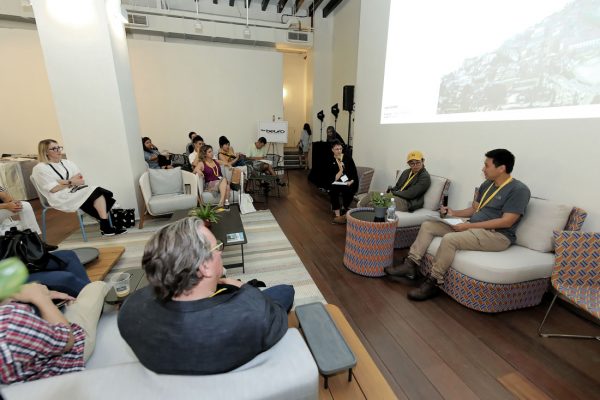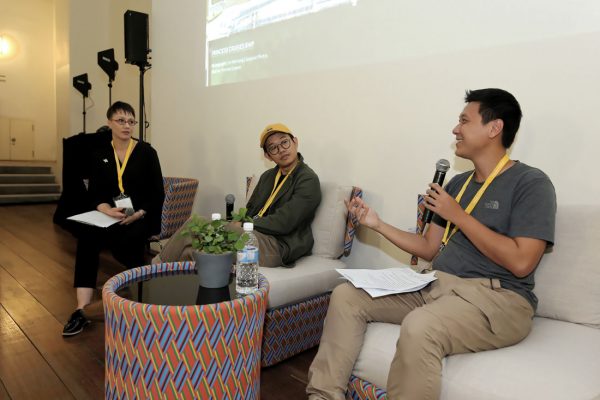Do you use a drone to shoot your projects, or have you ever commissioned a photographer to do so? Are your shots legal? Are they even necessary? We dared to ask at #SGID17.

Tiong Bahru. Photo by Lim Weixiang (Zeitgeist Photos)
October 13th, 2017
Everyone seems to love seeing aerial photographs of the built environment – even us in the media! But lately we’ve begun to exercise caution in using drone shots. Why? Because we wonder about the legality with which many of these incredible shots have been taken.
And a special #SGID17 Insights session at Singapore Indesign on 7 October we deduced that our caution is well founded. We invited photographer Lim Weixiang (Zeitgeist Photos) and Khoo Guojie (Studio Periphery) to share their experiences of using drones and their views on when drone shots actually add value to the understanding of a project.

Lim is an experienced drone user who is commissioned by architects, construction companies, developers, shipping companies, and government bodies. He noted that there’s been a considerable pick up in interest in drone photography over the last one or two years.
The regulations governing drone use in Singapore came into place in 2015, he explained. “Any time you use a drone for commercial reasons, you need to apply for a permit,” he said. “But not all permits will be approved. I was recently rejected for a permit – that’s $75 gone.”
Regulations include a height limit of 60 metres, prevent flying over roads and people, and prevent flying within a certain distance of airports. It’s quite possible that many people are taking drone shots illegally – perhaps without even realising it.
Khoo specialises in architectural and landscape photography. When asked how well informed his clients are about the regulations governing drone use, he suggested that sometimes he receives requests that are beyond the limits of the regulations. Naturally, he does not oblige. He holds reservations about how often drones are really necessary for architectural shoots.
“Everyone’s getting excited about drone photography, but a lot of design is better experienced from the ground. A lot of things can get lost when you go so high up. You have to work with the context of the space. The design has to impact the environment as well as be interesting enough for drone photography,” he said. “You have to evaluate and ask whether the project requires drone shots. What value will it add to your context? Will it add something more and go beyond falling into the drone trend?”

Are more architects asking for videos nowadays? Said Lim, “Construction and property companies are asking me for that. They want to see how the space is used, so I may set up a camera on a site for a week. Some architects also want to see how projects are being used.”
Is video becoming a standard for architects as a way of communicating a work? Said Khoo, “It’s becoming more so, but it depends on the scale and how the architect wants to study the building.” Added Lim, “It also depends whether they have the budget. Video costs more than photography because you have to spend a lot of time.” That said, from the architect or designer’s point of view, a video could have substantial payoffs (at least in terms of notoriety) if it goes viral on social media.
It emerged that there is a considerable amount of behind-the-scenes work and expense involved in drone photography that the A&D community may not be aware of. The photographer should be insured, for example. Lim spends a fair sum monthly for third-party insurance in case his drone falls and causes damage or injury. His insurer requires him to have a permit from CAAS (the Civil Aviation Authority of Singapore).
Liability for drone use rests with the photographers, not the people who hire them, says Lim. “Sometimes the budget a potential client has doesn’t justify the hassle I have to go through applying for the permit. Sometimes it doesn’t make sense for me to take up certain jobs.”

Navigating ‘geo-fences’ is another consideration for drone use. Lim explains, “In some places, geo-fence barriers are built into the software. That means a GPS limit is programmed in.”
Both Lim and Khoo think the fascination for drone photography will be enduring, but Lim expects the legal use of drones will become more difficult. Perhaps that’s especially so now, with the recent passing of the new Infrastructure Protection Act in Singapore. It requires authorisation for the taking of photos or videos of buildings with iconic or symbolic significance.
A searchable and comprehensive guide for specifying leading products and their suppliers
Keep up to date with the latest and greatest from our industry BFF's!

With the exceptional 200 Series Fridge Freezer, Gaggenau once again transforms the simple, everyday act of food preservation into an extraordinary, creative and sensory experience, turning the kitchen space into an inspiring culinary atelier.

The Man x Machine x Material collaboration by Jarrod Lim and The American Hardwood Export Council explores how generative AI can enhance design processes while also revealing the areas where human intuition remains irreplaceable.

In this candid interview, the culinary mastermind behind Singapore’s Nouri and Appetite talks about food as an act of human connection that transcends borders and accolades, the crucial role of technology in preserving its unifying power, and finding a kindred spirit in Gaggenau’s reverence for tradition and relentless pursuit of innovation.

The design at Fotografiska Shanghai honours the industrial legacy of the building, forming an authentic, multi-layered environment for photography exhibitions.

1 SHOT 24 explores these questions and more at the annual Image Makers Association Australia exhibition in partnership with Stylecraft, on display in Stylecraft showrooms across Australia.
The internet never sleeps! Here's the stuff you might have missed

The beauty of design often lies in its visual brilliance – the mesmerising forms, colours, and textures that ignite our collective imagination. But beneath the surface resides the quiet engineer of design integrity that ultimately determines its relevance and enduring impact: authenticity.

Fresh from Singapore, the first round of winners from day one of the World Architecture Festival have been announced.

The Man x Machine x Material collaboration by Jarrod Lim and The American Hardwood Export Council explores how generative AI can enhance design processes while also revealing the areas where human intuition remains irreplaceable.

For the Year 7 and 8 students of Xavier College, their dedicated Kostka Building feels warm, welcoming and offers myriad spaces for all types of social interaction. Living Edge has played an important role in this, working with MGS to supply furniture solutions that support their different learning activities.